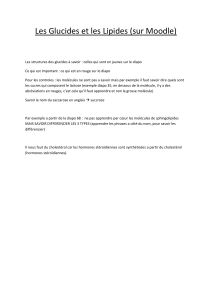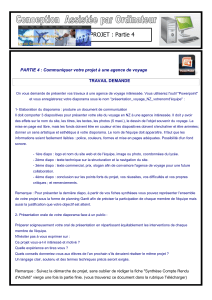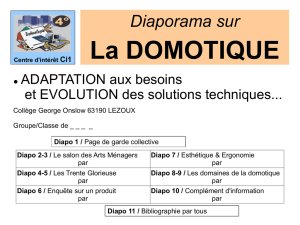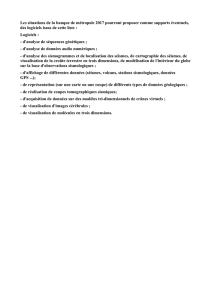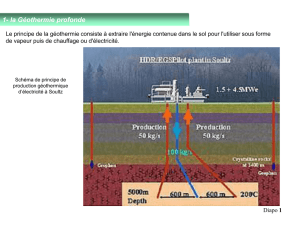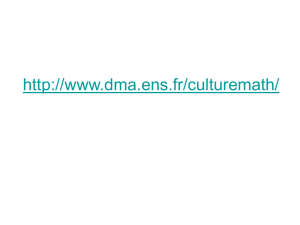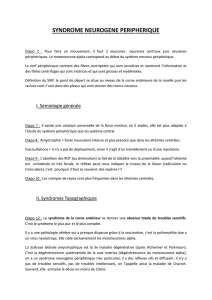Sommaire - Institut d`Optique
publicité
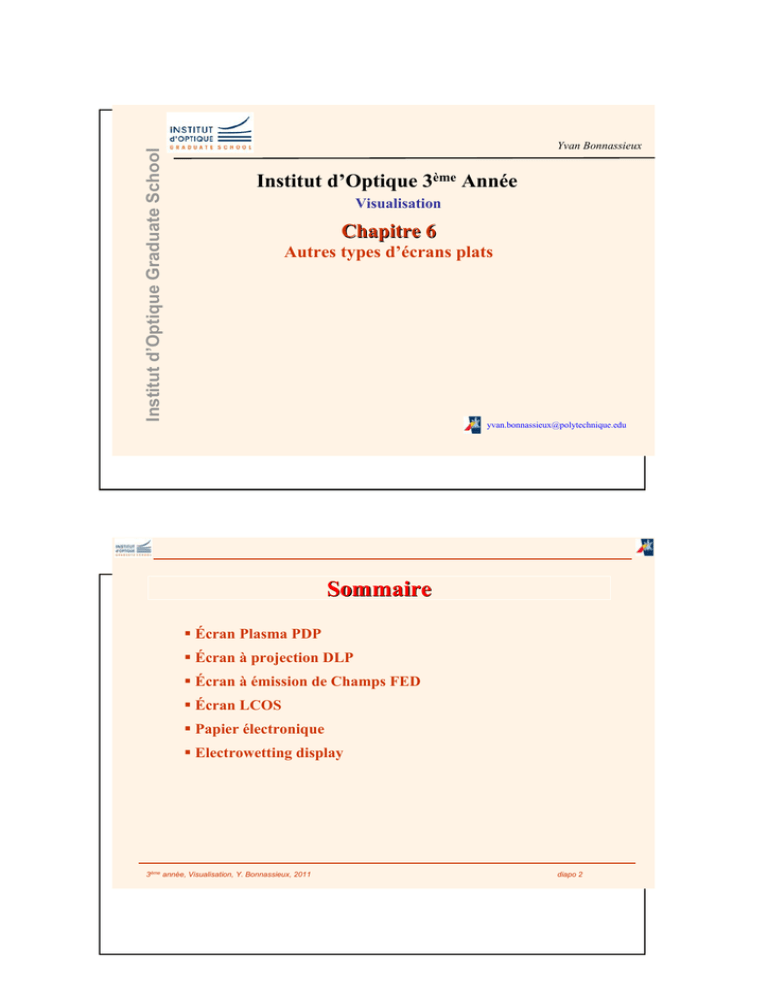
Institut d’Optique Graduate School Yvan Bonnassieux Institut d’Optique 3ème Année Visualisation Chapitre 6 Autres types d’écrans plats [email protected] Sommaire Écran Plasma PDP Écran à projection DLP Écran à émission de Champs FED Écran LCOS Papier électronique Electrowetting display 3ème année, Visualisation, Y. Bonnassieux, 2011 diapo 2 Écran PDP (Plasma Display Panel) 3ème année, Visualisation, Y. Bonnassieux, 2011 diapo 3 Écran Plasma (I) Historique 1964 Premier écran inventé par le « Coordinated Science Lab (CSL) » de l’Université de Illinois. 1966 écran monochrome 4 x 4 pixels 1967 écran monochrome 16 x 16 pixels 1993 écran couleur commercialisé par Fujitsu (42”) 1999 60” par LG, Samsung, NEC 2005 102” par Samsung 3ème année, Visualisation, Y. Bonnassieux, 2011 diapo 4 Écran Plasma (II) Principe des lampes fluorescentes • Un gaz rare (Argon, Néon, Xénon,...) enfermé dans un tube. • Électrodes haute tension (>200v). • Création d’un plasma (e- et ions libres) • DDP implique e- vers électrode + et ions vers la -. • Lors du déplacement chocs avec les atomes qui sont ainsi existés. • Retour à l'équilibre de l’atome par émission d’un photon. Nécessité de brasser le plasma pour en tirer un quelconque rayonnement tension alternative aux bornes du tube. 3ème année, Visualisation, Y. Bonnassieux, 2011 diapo 5 Écran Plasma (III) Principe des lampes fluorescentes La lumière émise par le plasma n'est pas visible. Il s'agit de rayonnements UV Spectre VUV de la décharge plasma d'un mélange Ne-Xe. • La raie fine à 147 nm correspond à la désexcitation 3P1-fondamental du Xe. • Le continuum autour de 173 nm provient de la désexcitation de l'excimère (Xe2)* La paroi du tube est recouverte d'une poudre sensible aux UV qui émet de la lumière blanche dans le cas des tubes domestiques. Ce phosphore est un scintillateur soit une matière qui convertit un rayonnement en un autre. 3ème année, Visualisation, Y. Bonnassieux, 2011 diapo 6 Écran Plasma (IV) Principe des Écrans Plasma Les luminophores scintillateurs (luminophores) adéquats. différentes natures selon la couleur désirée : Vert : Zn2SiO4:Mn2+ / BaAl12O19:Mn2+ 525 nm Rouge : Y2O3:Eu3+ / Y0,65Gd0,35BO3:Eu3+ 610 nm Bleu : BaMgAl10O17:Eu2+ 450 nm 3ème année, Visualisation, Y. Bonnassieux, 2011 diapo 7 Écran Plasma (V) Principe des Écrans Plasma •Chaque pixel est constitué de 3 microscopiques cavités identiques contenant un gaz rare (du xénon). •Chaque cavité dispose de deux électrodes : une avant et une arrière. •En appliquant une forte tension alternative sur chaque électrode, le plasma émet des UV qui viennent frapper les scintillateurs disposés au fond de chaque cavité. •Ces scintillateurs sont choisis afin d'émettre chacun une couleur primaire : rouge, verte, ou bleue. La lumière colorée traverse ensuite la vitre avant pour être perçue par l'utilisateur. 3ème année, Visualisation, Y. Bonnassieux, 2011 diapo 8 Écran Plasma (VI) Principe des Écrans Plasma Taille des Pixels La première difficulté rencontrée par les constructeurs : la taille même de ces pixels. Un sous-pixel plasma représente un volume de 200µm x 200µm x 100µm. Matériaux des électrodes •L'électrode avant doit être aussi transparente que possible. •L'ITO (indium tin oxyde) est employé matériau conducteur et transparent. •Malheureusement, la taille des écrans plasma est telle (les lignes d'ITO courent sur plus de 70 cm parfois) et l'épaisseur d'ITO si faible que la résistance électrique du matériau devient trop grande pour assurer une bonne propagation de la tension (300v). •On y adjoint souvent une fine ligne de chrome, malheureusement opaque mais bien meilleur conducteur. 3ème année, Visualisation, Y. Bonnassieux, 2011 diapo 9 Écran Plasma (VII) Principe des Écrans Plasma Structures Pixels •La courbe courant-tension d'une décharge dans le gaz montre l'existence d'une tension seuil d'amorçage très brève (de l'ordre de la nanoseconde, fonction de la pression du gaz et de la distance inter-électrode). •Ceci est très favorable à la réalisation d'un écran matriciel puisque cela permet le multiplexage complet de l'écran en quelques millisecondes (ms). •Le dispositif est protégé par un limiteur de courant (couche diélectrique). • Cette couche diélectrique a l'avantage de stocker les charges créées par l'ionisation du gaz et induit ainsi un effet mémoire au panneau. •La couche de magnésie additionnelle évite la dégradation prématurée du diélectrique due à la température et abaisse la tension d'allumage. 3ème année, Visualisation, Y. Bonnassieux, 2011 diapo 10 Écran Plasma (VIII) Principe des Écrans Plasma 3ème année, Visualisation, Y. Bonnassieux, 2011 diapo 11 Écran Plasma (IX) Principe des Écrans Plasma Principe de commande les électrodes sont alimentées par un signal d'entretien alternatif qui permet de maintenir la cellule dans l'état d'adressage. L'inscription ou l'extinction d'une cellule se fait par l'application d'une tension aux électrodes concernées. •Un créneau de faible amplitude (V<Ventretien) force la cellule à l'état éteint • un créneau de forte amplitude (V>Ventretien) force la cellule à l'état allumé. Cette dernière restera en activité par l'intermédiaire des charges stockées par le diélectrique (effet mémoire) 3ème année, Visualisation, Y. Bonnassieux, 2011 diapo 12 Écran Plasma (X) Principe des Écrans Plasma Principe de commande Autre structure plus répandue à l'heure actuelle est la dalle ACC (alternative coplanar current). Elle comporte 3 électrodes par pixels et non pas deux. 3ème année, Visualisation, Y. Bonnassieux, 2011 diapo 13 Écran Plasma (XI) Principe des Écrans Plasma Intensité des couleurs Dans la mesure où un pixel à plasma a besoin d'une décharge pour émettre de la lumière, ces derniers sont soit allumés, soit éteints mais ne disposent pas d'états intermédiaires. Du coup, les constructeurs optent pour un méthode de modulation de la luminosité en PCM (pulse code modulation) 3ème année, Visualisation, Y. Bonnassieux, 2011 diapo 14 Écran Plasma (XII) Comparaison des angles de vue 50” DLP 42” PDP 37” LCD 3ème année, Visualisation, Y. Bonnassieux, 2011 diapo 15 Écran Plasma (XIii) XIii) Comparaison du niveau de noir PDP LCD Front View Lower View 3ème année, Visualisation, Y. Bonnassieux, 2011 Right View Lower Right View diapo 16 Écran Plasma (XiV) XiV) Dégradation du phosphore 100 2005 PDP Company A (New phosphor) 95 CRT 2004 PDP Company A 90 2004 PDP Company B 2004 PDP Company C 85 80 0 1000 2000 3000 Operation time (hours) 4000 5000 6000 (Moving TV picture) 3ème année, Visualisation, Y. Bonnassieux, 2011 diapo 17 Écran Plasma (XV) Principe des Écrans Plasma • Réalisation de très grands écrans (supérieur à 55") • Émission de lumière très rapide. Avantages • Effet de seuil marqué (facilite le multiplexage) • Effet mémoire • Absence de papillotement (dû au mode d'adressage et à l'effet mémoire) • Angle de vue important (env. 160°, nettement supérieur au LCD) • Insensibilité aux interférences électromagnétiques Inconvénients •Sensibles au burn-in (vieillissement des luminophores) •coûte élevé. Structure compliquée & électronique de contrôle exige des semi-conducteurs très performants et spécifiques • Consommation élévé, (toujours > écrans LCD), est une des conséquences des tensions très élevées. (un écran à plasma de 107 cm 250W en PDP, 150W en AMLCD). • Taille des pixels 3ème année, Visualisation, Y. Bonnassieux, 2011 diapo 18 Écran Plasma (XVI) Ecran PDP 108’ (274cm) de diagonale, AQUOS Mai 2007 3ème année, Visualisation, Y. Bonnassieux, 2011 diapo 19 Écran DLP (Digital Light Processing) 3ème année, Visualisation, Y. Bonnassieux, 2011 diapo 20 Écran DLP (I) DLP Background • DLP Technology was invented in 1987 at Texas Instruments. • DLP Technology is based on a micro-electromechanical system (MEMS) device known as the Digital Micromirror Device (DMD). • DMD is a semiconductor-based array of fast, reflective digital light switches that precisely control a light source using a binary pulse width modulation technique. • Consists of 1280x1024) 480,000-1.3million mirrors (800x600 3ème année, Visualisation, Y. Bonnassieux, 2011 – diapo 21 Écran DLP (II) DMD Light Switch • Each light switch has an aluminum mirror (16 mm square) that can reflect light in two directions • Rotation of the mirror occurs from an electrostatic attraction between the mirror and underlying memory cell • System occupies 90% of projected image – mirrors separated by only 1 µm • LCD occupies 70% of the image 3ème année, Visualisation, Y. Bonnassieux, 2011 diapo 22 Écran DLP (III) DMD Light Switch 3ème année, Visualisation, Y. Bonnassieux, 2011 diapo 23 Écran DLP (IV) DMD Fabrication 3ème année, Visualisation, Y. Bonnassieux, 2011 diapo 24 Écran DLP (V) DLP Light Path • Light is projected to the lens only when the mirror is in the “ON” state (+10 degrees) • Memory cell in the “OFF” state (-10 degrees) will result in a dark pixel • Optical switching time is about 2 ms 3ème année, Visualisation, Y. Bonnassieux, 2011 diapo 25 Écran DLP (VI) DMD Grayscale • Pulse Width Modulation for a 4-bit word (16 gray levels) • Current DLP systems are either 24-bit color (8 bits or 256 gray levels per primary color or 30-bit (10 bits or 1024 gray levels per primary color 3ème année, Visualisation, Y. Bonnassieux, 2011 diapo 26 Écran DLP (VII) DMD Color Image DLP optical systems include a variety of configurations distinguished by the number of DMD chips (one, two, or three) 3ème année, Visualisation, Y. Bonnassieux, 2011 diapo 27 Écran DLP (VIII) DMD Color Image Rotating color wheel is used to create 16.7 million colors (true color) Rotates at 7200-10800 RPM depending on design 3ème année, Visualisation, Y. Bonnassieux, 2011 diapo 28 Écran DLP (IX) DLP product Projecteur vidé vidéo Télévision Ciné Cinéma 3ème année, Visualisation, Y. Bonnassieux, 2011 diapo 29 Écran FED (Field Emission Display) 3ème année, Visualisation, Y. Bonnassieux, 2011 diapo 30 Écran FED (I) History On Nov. 23, 1999 PixTech, Inc. announced the delivery of the first 12.1-inch Field Emission Display (FED) to the U. S. Army Samsung demonstrated a working carbon nanotube display prototype in 2001, with a 30-inch diagonal screen 3ème année, Visualisation, Y. Bonnassieux, 2011 diapo 31 Écran FED (II) FED Principles Field emission displays, electrons coming from millions of tiny microtips pass through gates and light up pixels on a screen. This principle is similar to that of cathode-ray tubes in television sets. The difference: Instead of just one "gun" spraying electrons against the inside of the screens face, there are as many as 500 million of them (microtips). Cathode The cathode/backplate is a matrix of row and column traces. Each crossover lays the foundation for an addressable cathode emitters. Each crossover has up to 4,500 emitters, 150 nm in diameter. This emitter density assures a high quality image through manufacturing redundancy, and long-life through low operational stress. 3ème année, Visualisation, Y. Bonnassieux, 2011 diapo 32 Écran FED (III) Emission Emitters generate electrons when a small voltage is applied to both row (base layer) and column (top layer). Pixels Faceplate picture elements (pixels) are formed by depositing and patterning a black matrix, standard red, green, and blue TV phosphors and a thin aluminum layer to reflect colored light forward to the viewer. 3ème année, Visualisation, Y. Bonnassieux, 2011 diapo 33 Écran FED (IV) Focusing Grid A focusing grid is layered on the cathode, collimating electrons to strike the corresponding subpixel, ensuring color purity and power efficiency Thin CRT Assembly Thin CRT is completed when cathode and faceplate are aligned, sealed and driver electronics are attached. Total display thickness is less than 8 millimeters. 3ème année, Visualisation, Y. Bonnassieux, 2011 diapo 34 Écran FED (V) Tip Selection Materials selection for field emitters is very critical. • Molybdenum is the most commonly used material. •Si emitters have also been fabricated and characterized because of their single-crystalline property and Compatibility with conventional(IC) fabrication process. •It has been reported that carbon-based material field emitters have a high potential for FED applications. The carbon-based materials, in nanotube, and diamond like carbon (DLC) forms, exhibit low effective work function,extraordinary hardness, chemical inertness, and high thermal conductivity, making it apparently suitable for high performance electron emitters. 3ème année, Visualisation, Y. Bonnassieux, 2011 diapo 35 Écran FED (VI) Metal Tips 3ème année, Visualisation, Y. Bonnassieux, 2011 diapo 36 Écran FED (VII) Si and DLC Coated Si Tips 3ème année, Visualisation, Y. Bonnassieux, 2011 diapo 37 Écran FED (VIII) Carbon Nanotube Carbon nanotubes are known for their superior mechanical strength and low weight, good heat conductance, varying electronic properties. Their ability to emit a cold electron at relatively low voltages due to high aspect ratios and nanometer size tips.Therefore, carbon nanotubes can be applied to field emitters for flat panel displays 3ème année, Visualisation, Y. Bonnassieux, 2011 diapo 38 Écran FED (IX) GaN Tips 3ème année, Visualisation, Y. Bonnassieux, 2011 A GaN field emitter is expected to exhibit a high emission current and a long lifetime, because it has the low electron affinity as well as high chemical and mechanical stability. diapo 39 Écran FED (X) FED by Futuba 3ème année, Visualisation, Y. Bonnassieux, 2011 diapo 40 Écran FED (XI) FED by Futuba 3ème année, Visualisation, Y. Bonnassieux, 2011 diapo 41 Écran FED (XII) SED by TOSHIBA 3ème année, Visualisation, Y. Bonnassieux, 2011 diapo 42 Écran FED (XIII) SED by TOSHIBA LOW CURRENT EFFICACY: Anode current < 1% Cathode current ► Cathode current is very high with as a consequence: - Cathode power consumption equivalent to the anode - Complex addressing to compensate the voltage drop in the rows. 3ème année, Visualisation, Y. Bonnassieux, 2011 diapo 43 Écran FED (XIV) Compares of Different Display PERFORMANCES POWER PDP Screen efficacy ( Including filters) 2,5 lm/W 1 Peak Brightness 500 Cd/m² Average Brightness Average display power consumption IMAGE QUALITY CRT Reference AMLCD SED CNTFED (7KV) (5 KV) 3 2 3 500 500 400 500 150 Cd/m² 150 500 120 150 100 W 200 120 70 Free Free 200 Low contrast at +/- 40° Viewing angle Free Free Response time 4ms 8ms 14ms 4ms 4ms 5000 1000 1500 10 000 5000 Wide Wide intrinsec contrast ( dark room) Grey level 3ème année, Visualisation, Y. Bonnassieux, 2011 Very wide Poor in the Poor in the black side black side diapo 44 Écran FED (XV) Comparse of Different Display FED LCD CRT EL Low Cost Wide Viewing Angle Rugged Sharpness Low Power High Resolution Thin Lightweight The Field Emission Display is a flat, thin, and low power CRT. FED technology provides CRT-like images. Users can enjoy full-color images from all viewing angles at true video speed with instant-on over a wide temperature range. 3ème année, Visualisation, Y. Bonnassieux, 2011 diapo 45 Ecran LCOS 3ème année, Visualisation, Y. Bonnassieux, 2011 diapo 46 Ecran LCOS (I) LCOS (Liquid Cristal on Silicon) 3ème année, Visualisation, Y. Bonnassieux, 2011 diapo 47 Ecran LCOS (II) 3ème année, Visualisation, Y. Bonnassieux, 2011 diapo 48 Ecran LCOS (III) 3ème année, Visualisation, Y. Bonnassieux, 2011 diapo 49 Papier Electronique 3ème année, Visualisation, Y. Bonnassieux, 2011 diapo 50 Papier Electronique (I) Principe élémentaire A gyricon sheet is a thin piece of transparent plastic that contains millions of small beads. Each bead--half white half black--is contained in an oil-filled cavity and is free to rotate within its cavity. 3ème année, Visualisation, Y. Bonnassieux, 2011 diapo 51 Papier Electronique (II) Structure d’ d’un écran 3ème année, Visualisation, Y. Bonnassieux, 2011 diapo 52 Papier Electronique (III) Chaine de production Roll to Roll 3ème année, Visualisation, Y. Bonnassieux, 2011 diapo 53 Papier Electronique (IV) Utilisation potentielle Pansement intelligente Carte à puce intelligente Étiquette intelligente Livre Électronique : Ebook 3ème année, Visualisation, Y. Bonnassieux, 2011 diapo 54 Papier Electronique (V) Utilisation actuelle : ee-reader Amazon Sony 3ème année, Visualisation, Y. Bonnassieux, 2011 diapo 55 Papier Electronique (V) 3ème année, Visualisation, Y. Bonnassieux, 2011 diapo 56 Papier Electronique (VI) Conclusion Inté Intérêts Inconvé Inconvénients •Très faibles coûts de fabrication •Bistable : conserve l’image même sans alimentation •Adaptable aux écrans souples •Monochrome •Faible temps de réponse ( <100ms) •Pas encore industrialisé 3ème année, Visualisation, Y. Bonnassieux, 2011 diapo 57 Electrowetting Display 3ème année, Visualisation, Y. Bonnassieux, 2011 diapo 58 Electrowetting Display (I) Electrowetting display principle •If no voltage is applied (a), the flat oil film results in a colored pixel. If a voltage is applied (b), the oil film contracts, resulting in reflection of incident light from the white substrate 3ème année, Visualisation, Y. Bonnassieux, 2011 diapo 59 Electrowetting Display (II) Display structure glass (or PET)/ITO water PET frame edge seal V active plate + fluoropolymer insulator photolithographic wall (~5 um) oil film 3ème année, Visualisation, Y. Bonnassieux, 2011 diapo 60 Electrowetting Display (III) 500x500 m2 pixel ElectroElectro-optic characteristics 15 m magenta oil 40 14 30 12 25 Reflectivity (%) 1.0 20 15 10 10 8 -20 V 0.5 6 0V 0.0 400 5 4 500 600 700 Wavelength (nm) 0 0 -5 -10 -15 -20 Contrast at 550 nm Reflectivity at 550 nm (%) 16 35 2 0 -25 Voltage (V) 3ème année, Visualisation, Y. Bonnassieux, 2011 diapo 61 Electrowetting Display (IV) Video speed response time ton 250x250 mm2 Rmax 15 mm oil Normalized Reflectivity - 30 V ton = 12 ms on off toff = 13 ms 0V Rmin 0 5 10 toff 15 20 25 30 Time (ms) 3ème année, Visualisation, Y. Bonnassieux, 2011 diapo 62 Electrowetting Display (V) Subtractive color arrays Magenta 5 um pixel walls Cyan Yellow 80 um 250 um 3ème année, Visualisation, Y. Bonnassieux, 2011 diapo 63 Electrowetting Display (VI) Advantage of reflective electrowetting display • Video speed response (<10 ms) • High brightness color option (4xLCD) • Well suited for high resolution (now 160 dpi) • Good intrinsic properties for flexible display (no cell-gap dependence) Paper-like look and feel possible 3ème année, Visualisation, Y. Bonnassieux, 2011 diapo 64 Electrowetting Display (VII) Les produits 3ème année, Visualisation, Y. Bonnassieux, 2011 diapo 65
